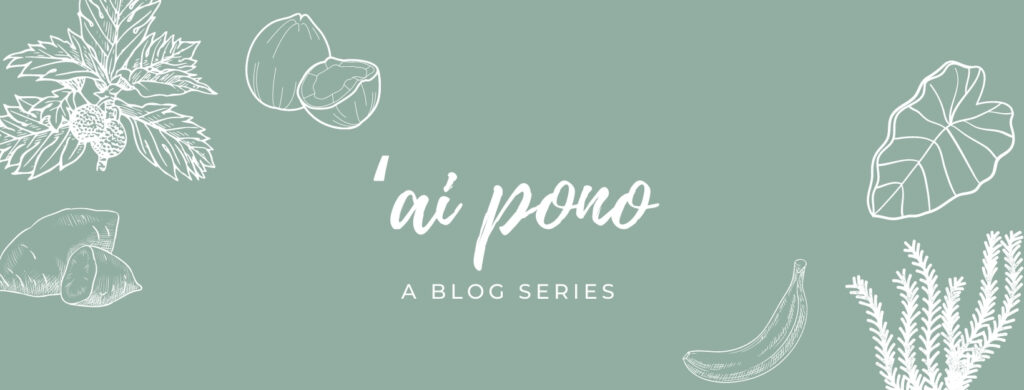Holoiʻa ka papa, kau ʻia e ka manu. Where there is food, people gather.
Food is central in every culture, fostering traditions and a sense of community, while also providing us with the nutrients we need to live. In ‘Ai Pono, we will explore the interconnectedness of Native Hawaiian food systems and access, nutrition, and sustainability. Through this series, we will attempt to draw connections between traditional Native Hawaiian food and health/well-being.
To start this series, we will take a glance at how kalo, which is also referred to as “The Staff of Life,” has fulfilled this title and the role it plays in Native Hawaiian diet and culture.
From the beginning, we can see the significance of kalo in Native Hawaiian culture. The origin of kalo comes from when the sky father Wākea and earth mother Papa gave birth to their first child Hāloa, who did not survive and was buried. From the spot he was buried, the first kalo plant sprouted.¹Wākea and Papa had a second child, Hāloanakalaukapalili, whose children became the Hawaiian people. Thus, kalo has come to represent the idea of a family with the main stalk representing the parent and the offshoots as the children.² We can see this even in the etymology of words like ‘ōhana, as the ‘ohā derives from the word for the shoots that sprout from the main kalo plant.¹
Pre-contact, kalo was the primary crop grown in wetlands. By the end of the 19th century, though, the acreage of land devoted to kalo farms had decreased from 50,000 to 30,000, and since 1965, only around 400 acres of land have been devoted to kalofarms.³ After western explorers colonized the Hawaiian Islands, the demand and supply for kalo fell as kūpuna with agricultural knowledge died from diseases that settlers introduced and resources that previously were dedicated to growing and nurturing kalo were diverted to growing foods like rice and sandalwood for export.⁴
Kalo was also a highly nutritious food and one of the staple carbohydrates in the traditional Native Hawaiian diet. All parts of the kalo plant are edible as the leaves and stems can be cooked as greens and the tubers baked, boiled, mashed, steamed, or cooked.² Additionally, the main corm plant provides potassium, fiber, calcium, and iron, while kalo leaves provide sources of provitamin A carotenoids, vitamins C and B₂, and vitamin B₁.¹ With the decreased prevalence of kalo and other traditional Native Hawaiian foods in peoples’ diets came higher rates of obesity and diabetes – issues that Native Hawaiians continue to disproportionately experience today.⁷
It was estimated that, pre-contact, Native Hawaiians ate up to 15 pounds of poi a day.⁵ Over the years, though, the price of taro and poi have been rising as the price of taro rose from 57 cents per pound in 2006 to 62 cents per pound in 2008, and the price of a pound of poi rose from $4 to anywhere between $5 and $7.99 or higher at grocery stores.⁴ Today, a pound of poi at Safeway can cost anywhere from $6.99 to $11.99 or $7.99 to $12.99 at Foodland. This is a lot compared to the average price of a meal in 2020 in Hawai’i, which is estimated at being around $3.39, according to Feeding America.⁶ As the prices of traditional foods rise over time, it becomes more difficult for people to incorporate it into their diets when they become unaffordable. This leads people to turn toward purchasing cheaper, often less nutritious foods, in turn, impacting their health.
The resounding impacts that a decreased prevalence of and harder access to kalo has had over time demonstrates the important role that food plays in our lives. Over the next couple of months, we will continue exploring topics of food access, nutrition, and food systems, and how we can connect with food on a deeper level.
Na Maris Tasaka
Further Readings/Media:
- Seasons of HĀLOA
- Hawaiian History Month ‘Āina Momona Webinar
- Hawaiian Kalo, Past and Future
- On Hawaii, the Fight for Taro’s Revival
Citations
- Cho JJ, Yamakawa RA, Hollyer J. 2007. Hawaiian kalo, past and future. Honolulu (HI): University of Hawaii. 8 p. (Sustainable Agriculture; SCM-1).
- Lincoln, Noa Kekuewa, and Peter Vitousek. “Indigenous Polynesian Agriculture in Hawaiʻi.” Oxford Research Encyclopedia of Environmental Science. 29 Mar. 2017; Accessed 3 Mar. 2021.
- Kagawa-Viviani, Aurora; Levin, Penny; Johnston, Edward; Ooka, Jeri; Baker, Jonathan; Kantar, Michael; Lincoln, Noa K. 2018. “I KeĒwe ʻĀina o Ke Kupuna: Hawaiian Ancestral Crops in Perspective” Sustainability 10, no. 12: 4607.
- Taro Security and Purity Task Force. 2009, Taro Security and Purity Task Force 2010 Legislative Report.
- Mishan, Ligaya. “On Hawaii, the Fight for Taro’s Revival.” The New York Times, 8 Nov. 2019.
- “Hunger in Hawaii.” Feeding America
- Look, M.A., Soong S., Kaholokula, J.K. (2020). Assessment and Priorities for Health and Well-Being in Native Hawaiians and Pacific Islanders. Honolulu, HI. Department of Native Hawaiian Health, John A. Burns School of Medicine, University of Hawai‘i

